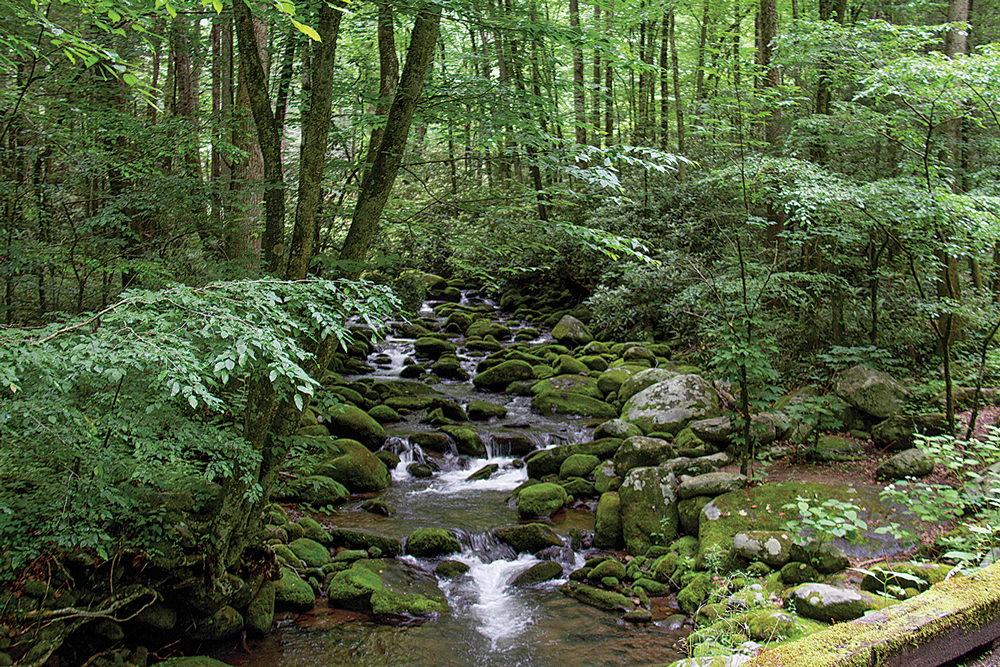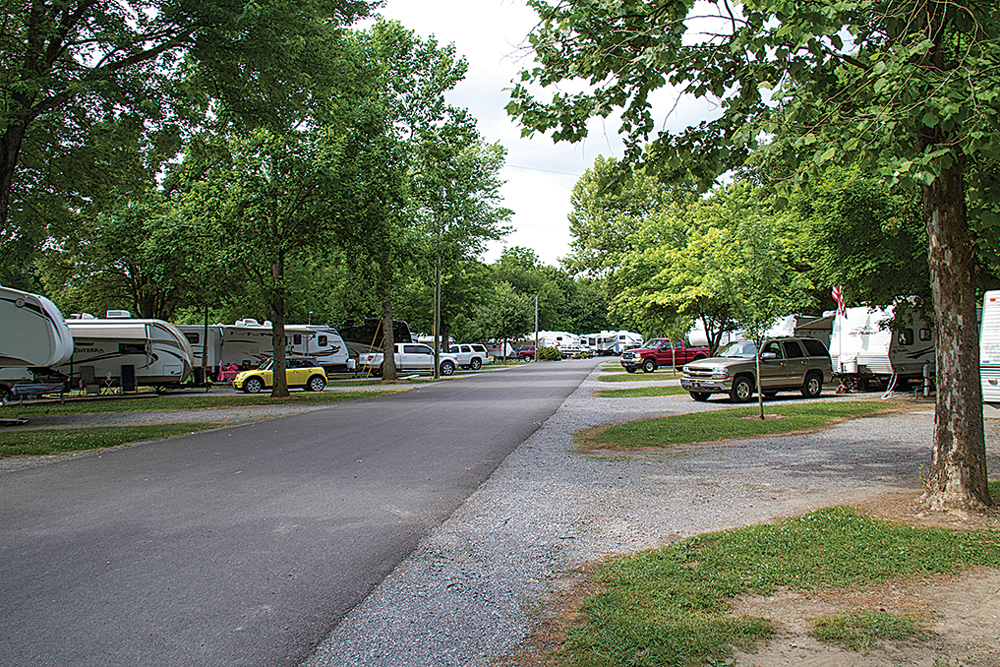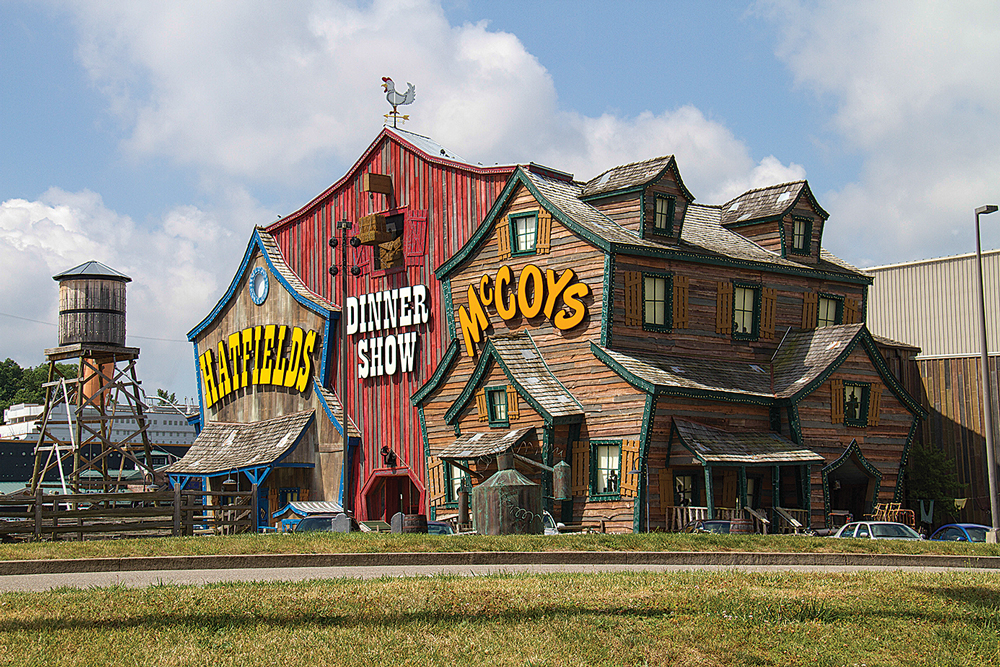On the border of North Carolina and Tennessee, small towns charm visitors, rivers and streams converge, and ridge after ridge of forested landscape drape ancient mountains in America’s most visited national park
One of the most mesmerizing and naturally beautiful areas of this country lies on the border between North Carolina and Tennessee. I have had the privilege of visiting the Great Smoky Mountains on two occasions and have been fascinated with my findings each time. The Smokies have a rich history, which includes occupation by Native Americans and later settlement by immigrant populations from northern Europe.
Great Smoky Mountains National Park was created in 1934 to preserve the land and rich forest areas for generations. It is into this beautiful setting that tourists numbering up to 9 million a year come to enjoy nature’s bounty. Just outside the park in Tennessee are three small cities — Sevierville, Pigeon Forge and Gatlinburg — that offer a multitude of attractions for visitors and no shortage of RV parks.
Unlike most national parks, entrance to Great Smoky Mountains National Park is free. The easiest way to get around is by vehicle, and many accessible roads bring visitors to almost every corner of the park’s nearly 522,000 acres. Elevations range from 870 feet to well over 6,500 feet, giving hikers ample opportunity to test their skills.
Waterfalls abound, and seven major ones are relatively easy to get to from their respective trailheads. Distances range from cascades that can be seen from the road, such as Meigs Falls, to Abrams Falls, a moderate 5-mile round-trip hike from the trailhead in Cades Cove. More information on this and other hikes can be obtained from visitor centers in the park. One good source is the free What-To-Do guide that is widely available at park information centers.
Here, however, let’s concentrate on three driving tours that get a great deal of attention and use. The first is Newfound Gap Road, which bisects the park almost in half from northwest to southeast. This is a beautiful though curvy trail with many pullouts that allow visitors to view the majestic rolling hills and valleys of the Great Smokies. This road brings visitors from Tennessee over the top to the North Carolina side of the park.
At the top of Newfound Gap is a large parking area that crosses the Appalachian Trail, which passes through most of the national park. From this point hikers can climb to Clingmans Dome, the highest point in the park at just over 6,600 feet. Newfound Gap is also the border between Tennessee and North Carolina. Visitors can continue on their route to the Mountain Farm Museum and Mingus Mill, a collection of historic log buildings, and the park’s southeast entrance in North Carolina. Views from this road are spectacular, and when the weather is right, you can see the fog-filled canyons that give the Smoky Mountains their name. In fall the colors of the hardwoods make this trail a dramatic drive.
A second well-traveled driving route is the Roaring Fork Motor Nature Trail. In summer this beautiful roadway passes through some of the lushest hardwood forests anywhere. The trail is a very popular attraction, so driving it with a large vehicle is not recommended. Parking in many of the pullouts becomes a real problem during peak season, so it’s advised that travelers take the trail early in the day.
The trail is a one-way loop that begins and ends just outside the town of Gatlinburg, Tennessee. Many hiking trails spur off from it, as do several restored homesteads that visitors can easily walk to. Be sure to stop at some of them to relive the environment of this area 150 years ago. Abundant wildflowers pop up in late spring and summer, and bubbling mountain streams echo through the forest. The route is closed in winter.
Lastly, the 11-mile Cades Cove Loop offers yet another enchanting drive, accessible via Laurel Creek Road at the north end of the park. This is another extremely popular drive, especially in autumn when the leaves turn. This area was settled by Europeans in the early 19th century, and many structures from that era have been maintained by the National Park Service.
“There are trees here that stood before our forefathers ever came to this continent; there are brooks that still run as clear as on the day the first pioneer cupped his hand and drank from them. In this park, we shall conserve these trees, the pine, the redbud, the dogwood, the azalea, the rhododendron, the trout and the thrush for the happiness of the American people.”
— President Franklin D. Roosevelt
The Cades Cove Loop is a one- way road that passes 19 tour stops marked for self-guided tours. In addition to the beautiful scenery, live demonstrations are held in the warmer months to show visitors how early settlers made molasses, soap and apple butter.
Along the loop, wildlife sightings are common, and on our drive we saw several turkey, deer and even black bear. In addition to picturesque hardwood landscapes, we also beheld beautiful pastures with rugged mountain backgrounds. It’s a real haven for photographers.
Access to the park is easy from either the Tennessee or North Carolina side. The Tennessee towns of Gatlinburg, Sevierville and Pigeon Forge offer an immense variety of attractions that shouldn’t be missed. Amusements of all sorts can be found throughout the region, from go-kart racing and miniature golf to wax museums and playhouses. There’s no shortage of entertainment with several theaters providing country-western productions as well as many dinner-theater shows. A wide variety of restaurants suits all tastes, and wineries have sprung up as well. If golf is your forte, eight golf courses await, and shopping, too, is available in abundance, including outlet malls and retail shops. A variety of events are scheduled throughout the peak season and include barbecue cookoffs, music festivals and Oktoberfest celebrations.
Traffic can be a problem, especially on weekends, and vacationing families are everywhere. The plus side of this is that there are simply tons of things to see and do. The downside is that the variety of entertainment draws crowds, so expect congestion throughout the peak summer months.

One of many small streams that inundate the Roaring Fork Motor Nature Trail. The entrance to the trail is just a short distance past the parking areas for Rainbow Falls.
One feature of this region that should be emphasized is local crafts. Just outside Gatlinburg is a large arts-and-craft community along an 8-mile-loop that houses many shops and workshops. To get there, turn on East Parkway at the third light in Gatlinburg and continue on to Glades Road. Take a left and follow the loop all the way around to find some very interesting crafts. Numerous ceramics shops along the way sell every form of pottery and offer demonstrations. There are also broom makers, jewelry makers, glassblowers and chair makers. The shopkeepers are friendly and very much interested in discussing their merchandise and how it’s made. I was particularly fascinated with the pottery works and one shop that contained a variety of wood products from chairs to wooden fruit.
RVers are welcome, as evidenced by the number and quality of RV resorts and campgrounds. We stayed at River Plantation RV Resort in Sevierville and were pleased by the accommodations. The roads are paved and the sites good-sized, and we were fortunate to get a well-shaded site on the Pigeon River. The resort sits between Sevierville and Pigeon Forge and has full RV accommodations, a nice swimming pool and even a convention center for groups. From the resort there’s easy access to attractions, restaurants and entertainment. Reservations are recommended well in advance at all of the RV parks in the area.
While I’ve mentioned the sites that can be seen from driving tours, don’t discount the many hiking opportunities. Some 800 miles of forested trails crisscross the park. Several visitor centers offer good supplies of resources to help travelers decide how to spend their time.
The Great Smokies are truly an area of enchantment — no wonder this beautiful national park is the most visited in the country.
Camping in the Great Smokies
NATIONAL PARK CAMPGROUNDS
Nine campgrounds in Great Smoky Mountains National Park accommodate RVs of varying lengths. Abrams Creek, Balsam Mountain, Deep Creek and Look Rock campsites are first-come, first-served. Cades Cove, Cataloochee, Cosby, Elkmont and Smokemont campsites may be reserved at 877-444-6777 or www.recreation.gov. For information call 865-436-1200 or visit www.nps.gov/grsm.
RV PARKS AND RESORTS
Communities surrounding Great Smoky Mountains National Park have no shortage of private RV parks, particularly on the Tennessee side.
Creekside RV Park
Pigeon Forge, Tennessee
800-498-4801
www.creeksidervpark.com

Campsites at River Plantation RV Resort in Sevierville, Tennessee, offer a peaceful, natural environment.
River Plantation RV Resort
Sevierville, Tennessee
800-758-5267
www.rvcoutdoors.com
Twin Creek RV Resort
Gatlinburg, Tennessee
800-252-8077
www.twincreekrvresort.com
Yogi Bear’s Jellystone Park Camp-Resorts
Cherokee, North Carolina
877-716-6711
www.jellystonecherokee.com



